Welcome back to my series on the history of Mundelein! When we left off in my last post, it was April 1979: Mundelein’s first computer store, ComputerLand, was promoting “micro-computers” as the next big thing, the old Ray brothers pavilion had been re-opened as the Diamond Lake Beach & Recreation Center, and residents were still celebrating an incredibly successful business expo. We have another twenty years of history to cover, from the excessive ’80s to the EXTREME ’90s, something I have personal memories of, so let’s get started!
By 1980, Mundelein’s population, while not growing as rapidly as it had in the ’50s and ’60s, was still growing, reached 17,053 in 1980. This, in combination with an influx of new businesses, led to the construction of a number of new subdivisions, including Cambridge West, Cambridge Countryside, and Fields of Ambria. At the same time, the average family income for residents, while growing more slowly than in neighboring communities, was around $27,394 ($81,292 today). In early 1981, the village, still fresh off the success of the ’79 business expo, began planning a follow up to be held at Mundelein High School on April 4, 1981, with 31 local businesses and industries to be in attendance. In short, Mundelein, as the then-new town slogan said, was a place “Where Youth Have a Future!”

Then, on March 5, 1981, in what then-Mayor Colin McRae called a “terrible blow,” the Ball Corp., the third largest employer in Mundelein, announced it would be closing its glass manufacturing plant on April 1, just three days before the Mundelein Business Expo ’81 (Independent Register 1981, p.1). The plant’s closure resulted in the loss of 125 jobs and approximately $90,000 in property taxes for the village. Despite this unexpected shock to Mundelein’s economy, the ‘81 Business Expo went ahead as scheduled, but due to poor weather, including a tornado warning, attracted only 800 people compared to the 2,000 of the earlier expo. Four months later, Mayor McRae, who despite the plant’s closure won re-election on Tuesday April 7, with 75% of the vote, was faced with another blow to the area’s economy as the economic recession of the early 1980s began to take its toll.
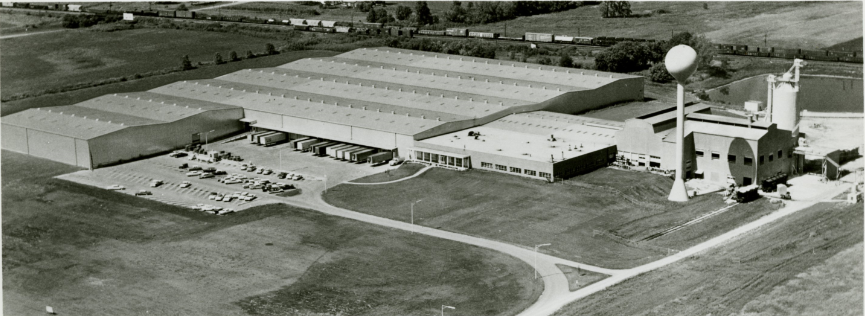
Despite the economic downturn, life in Mundelein went on. In 1982, my family moved into a small, single-family house in the Lakewood Heights subdivision, just in time to watch an unusual sight: an old train depot traveling, albeit very slowly, down the streets of Mundelein.
In October 1980, Leonard Schmitt, the president of the Historical Society of the Fort Hill Country, learned that the abandoned Soo Line Depot was scheduled for demolition. He suggested moving the depot to be used as a local history museum. After three years of delays due to regulatory red tape, the depot was relocated over the course of two days starting on August 1, 1983. Residents of Mundelein, including my parents, watched as slowly and carefully, workers from Advanced Moving Contractors Inc. began the long process of moving the depot to its new home at Lions Field, donated by the Mundelein Park District and located on Noel Drive across from Fairhaven School. The move cost upwards of $16,000 ($39,280 today), not including the extensive renovations that were required. After almost five years of work, the Fort Hill Heritage Museum, housing a diverse collection of historical artifacts from Mundelein and Lake County, opened its doors to the public on July 4, 1987.
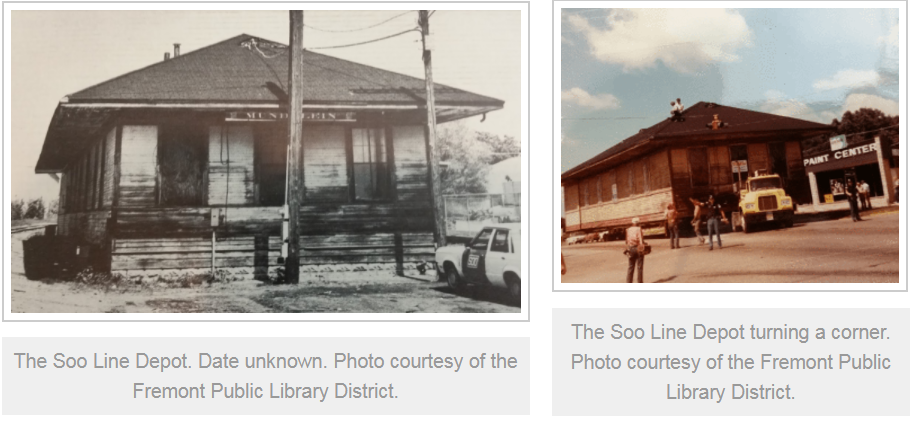 In 1984, a local paper, the Fremont Patriot, reverted to its original name the Mundelein News, just in time to report that Medline Industries, at the time the nation’s second largest distributor of medical products, was going to be moving their headquarters from Northbrook to Mundelein, taking over the abandoned Ball Corp. glassware plant. Their move was part of a larger trend that saw companies like Abbott and Baxter opening offices in Lake County. To assist the company in its move, the Mundelein Village Board issued $7.5 million in industrial bonds, which in turn was expected to bring more than 500 jobs to the area. Medline’s new headquarters, which also housed manufacturing and distributing facilities, officially opened on Saturday October 13, 1984 with much fanfare, a ribbon cutting ceremony, and Medline presenting then-mayor McRae with a cake in honor of Mundelein’s 75th anniversary.
In 1984, a local paper, the Fremont Patriot, reverted to its original name the Mundelein News, just in time to report that Medline Industries, at the time the nation’s second largest distributor of medical products, was going to be moving their headquarters from Northbrook to Mundelein, taking over the abandoned Ball Corp. glassware plant. Their move was part of a larger trend that saw companies like Abbott and Baxter opening offices in Lake County. To assist the company in its move, the Mundelein Village Board issued $7.5 million in industrial bonds, which in turn was expected to bring more than 500 jobs to the area. Medline’s new headquarters, which also housed manufacturing and distributing facilities, officially opened on Saturday October 13, 1984 with much fanfare, a ribbon cutting ceremony, and Medline presenting then-mayor McRae with a cake in honor of Mundelein’s 75th anniversary.
Events like Medline’s grand opening were the exception however, and by the early ’90s, thanks to the draw of the neighboring Vernon Hills mall, the original downtown area of Mundelein was facing a serious decline, with cracked and crumbling sidewalks, vacant storefronts, and a high turnover rate in businesses. In response, the Village Board contracted with Thompson Dyke & Associates, Ltd. to devise a comprehensive plan to improve the Village’s image and promote economic growth. The plan that was eventually presented recommended the maintenance of a “small town atmosphere,” repairing the sidewalks to make the downtown more pedestrian-friendly, and making the downtown the focal point for business and cultural events within the community (Thompson Dyke & Associates, 1990). Following the presentation, a committee was formed to investigate the National Main Street Center approach, a program by the National Trust for Historic Preservation to combat economic decline in downtowns across the nation. It was decided to move forward with the plan and in June 1993, “Mundelein Pride”, later changing its name to “Mundelein Main Street” in 1998, was officially incorporated. Operating out of the then-vacant Lincoln School basement, the group was instrumental in lobbying for a new Metra Rail Station, rebuilding Kracklauer Park, and providing loans to enable property owners to renovate their buildings.
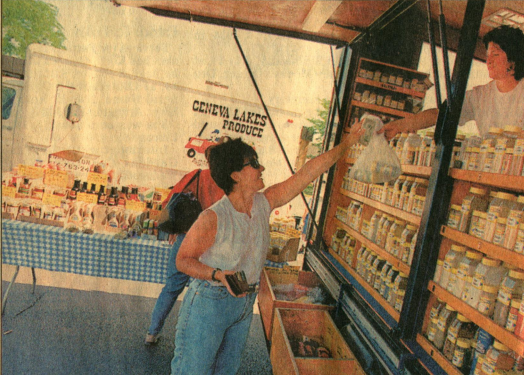
In 1994, just as Mundelein, with the help of Mundelein Pride, was attempting to recapture that “small town atmosphere,” Jim Carew, a retired Mundelein firefighter who collected and restored old fire trucks as a hobby, received an unexpected call. “The truck has to go. It’s yours if you can get here in three days. Otherwise, it’s going for scrap,” said the caller (Old Number One Preservation Committee, 2017). The truck in question was the old Stoughton fire truck that Cardinal George Mundelein had given to the town as a gift, which by then was sitting in pieces in a barn in North Carolina. Realizing what was at stake, Jim contacted Father Tom Franzman, a priest at St. Mary of the Lake Seminary, as well as a fellow fire truck enthusiast, and the two drove the over 800 mile journey to bring the truck, affectionately known as Old Number One, back home. Putting the pieces of the truck into milk crates and bushel baskets, the two got the truck back to Jim’s garage, where he set about the slow task of finding the parts needed to restore the old fire engine and waiting for the village to call.
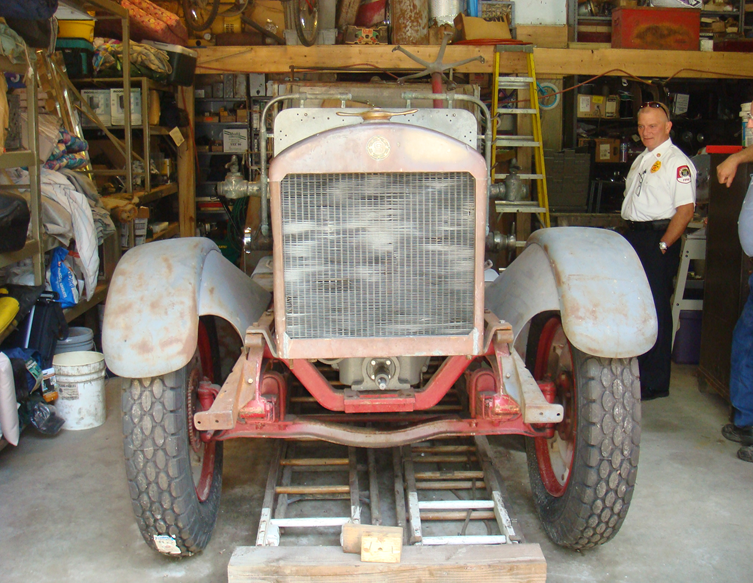
On March 17, 1998, residents approved a $10 million bond for the construction of a new facility to house the Fremont Public Library on land donated by Town & Country Builders to the village, which, in turn, donated the land to the library district. Located on North Midlothian Road next to Mechanics Grove Elementary School, the new library was a two-story building with 78,000 square feet of space to house the library’s collection in addition to study rooms and a dedicated computer lab. Breaking ground at 2:00 pm on April 18, 1999, the contractors from Camosy General Contractors worked quickly and, month by month, the new library took shape. Opening its doors at 1 pm on Sunday September 9, 2001, the librarians were met with eager patrons whose enthusiasm was dampened a bit with the news that due to a mistake by Ameritech, the library’s computers were not up yet, meaning that patrons were unable to check out books or use the Internet. In spite of this hiccup, the library’s opening was widely regarded as a resounding success.
The festivities surrounding the dawning of the new millennium came and went, the threat of Y2K turned out to have been vastly overstated, and overall the first year of the twenty-first century was a relatively uneventful one for residents of Mundelein. The population of the village was up to 30,935, Mundelein Mainstreet’s efforts were beginning to pay off, little by little, with new businesses like Garden Fresh and Bone Appetit opening, and construction on the village’s new police station, located on North Lake Street, just getting underway. It seemed like the 21st century was going to be not unlike the one that had preceded it.
Then, at 8:46 am on September 11, 2001, American Airlines Flight 11 crashed into the northern tower of the World Trade Center. Like many students and teachers at the Carl Sandburg Middle School, I spent that day glued to the TV, watching as news reports came in, each worse than the last and trying to understand what was happening. In the days the followed the attack, residents of Mundelein came together to offer what help they could to the victims, even as they struggled to cope with what had happened. Mundelein Main Street donated all the proceeds from the group’s Classic Car Cruise Night to the Red Cross while other groups collected funds or set up blood drives. At Carmel High School, students and staff held a prayer service while parishioners packed Mundelein’s churches from Marytown chapel to Saint Andrews Lutheran Church seeking answers.
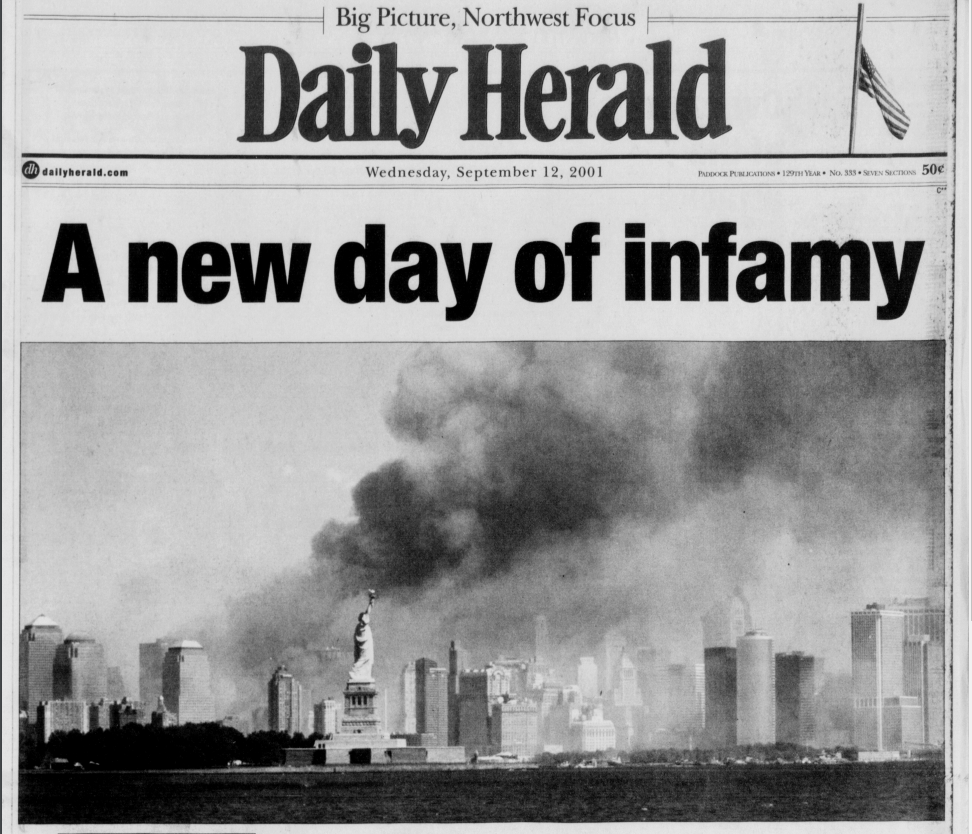
That was the state of Mundelein at the beginning of the 21st century: a downtown struggling to retain business, a rescued 1925 Stoughton fire truck, a new library, and residents still coming to terms with a world that seemed more dangerous than ever. Now usually, this is where I’d give you a preview of what my next installment on the history of Mundelein would cover, but I’m taking a short break from the series because next month Libertyville’s very own Masonic lodge is celebrating a belated 150th anniversary! So join us next time to learn how members of Masonic lodge #492 helped make Libertyville what it is today and just how ice cream became their most expensive item in their line item budget!
“A new day of infamy .” Daily Herald (Arlington Heights), September 12, 2001, sec. 1. Accessed August 11, 2017. https://access.newspaperarchive.com/us/illinois/arlington-heights/daily-herald-suburban-chicago/2001/09-12/.
Cole, Bill. “Mundelein set for business renewal.” Daily Herald (Libertyville), March 3, 1999.
“Depot relocation set for July 28.” Independent Register (Libertyville), July 21, 1983. Microform.
“Depot reaches destination at last.” Independent Register (Libertyville), August 4, 1983. Microform.
Dill, Kathryn . “Mundelein’s old No. 1 firetruck speeds toward restoration.” Chicago Tribune, July 24, 2009. Accessed August 8, 2017. http://articles.chicagotribune.com/2009-07-24/news/0907220490_1_firetruck-restoration-fire-engine.
“Fremont Library plans ground breaking April 18.” Mundelein Review, April 8, 1999.
“Fremont library to close; Officials to discuss building’s future.” Lake County News-Sun (Gurnee), May 23, 1998.
Grom, Korrina. “Building for the future.” Mundelein News, July 30, 1999.
Grom, Korrina. “Fremont Library Board accepts $9.2 million bid.” Mundelein News, March 26, 1999.
“Guide to Mundelein Business Expo ’81.” Independent Register (Libertyville), April 2, 1981. Microform.
Hayes, Jack. “Out of the quiet comes a boom: Growth propels unassuming villages toward new era.” Chicago Tribune , January 27, 1988. Accessed July 17, 2017. https://search.proquest.com/chicagotribune/docview/882621565/DED944B6CD541BAPQ/16?accountid=44868.
King, Jason. “Local churches offer comfort in face of evil.” Daily Herald (Arlington Heights), September 12, 2001. Accessed July 24, 2017. http://infoweb.newsbank.com/resources/doc/nb/news/0EE8511FA892E7B5?p=NewsBank.
Krishnamurthy, Madhu. “County residents answer call to help victims of terrorism.” Daily Herald (Arlington Heights), September 13, 2001. Accessed July 24, 2017. http://infoweb.newsbank.com/resources/doc/nb/news/0EE85125A01A56E0?p=NewsBank.
Lissau , Russell . “Schools lock doors, struggle to cope.” Daily Herald (Arlington Heights), September 12, 2001. Accessed July 24, 2017. http://infoweb.newsbank.com/resources/doc/nb/news/0EE8511F907ADE61?p=NewsBank.
Lissau, Russell. “State putting $150,000 in Fremont Library pot.” Daily Herald (Libertyville), July 15, 1999.
Lissau, Russell. “Truck that was almost history is now part of it.” Daily Herald (Libertyville), October 5, 2008. Accessed June 28, 2017. https://access.newspaperarchive.com/us/illinois/arlington-heights/daily-herald-suburban-chicago/2008/10-05/page-142?tag=russell lissau&rtserp=tags/russell-lissau?psb=dateasc&page=2&ndt=ex&py=2008&pm=10.
Lissau, Russell, and Jason J. King. “New Fremont library opening – but with no checkouts for now.” Daily Herald (Arlington Heights), January 6, 2001. Accessed June 20, 2017. https://access.newspaperarchive.com/us/illinois/arlington-heights/daily-herald-suburban-chicago/2001/01-06/page-170?tag=russell lissau&rtserp=tags/russell-lissau?ndt=ex&py=2001&pm=1&psb=dateasc.
Mikus, Kim . “Mundelein stores head for greener pastures.” Daily Herald (Libertyville), May 23, 1994.
Mohr, Robin. “Empty Kmart, Welton’s store drain Mundelein.” Daily Herald (Libertyville), June 29, 1995.
Oakley, Andy. “New firm praises Mundelein’s aid.” Daily Herald (Arlington Heights), October 13, 1984, sec. 2. Accessed August 11, 2017. https://access.newspaperarchive.com/us/illinois/arlington-heights/daily-herald-suburban-chicago/1984/10-13/page-11?tag=medline&rtserp=tags/medline?psb=relavance&pci=7&ndt=by&py=1980&pey=1989&psi=37&ndt=ex&py=1984.
Old Number One Preservation Committee. The Story of Mundelein’s first fire truck, known affectionately as “Old Number One”. Mundelein , IL, 2017.
“Our History.” Mundelein Community Connection. Accessed July 13, 2017. http://www.mundeleincommunityconnection.org/about-us.html.
Photos courtesy of the Minnietrista Heritage Collection, Fremont Public Library District, Village of Mundelein, Old Number One Preservation Committee, and Mundelein Community Connections.
Schaeffer, Kathy. “Medline moving fast in Mundelein.” Daily Herald (Arlington Heights), September 25, 1984. Accessed June 27, 2017. https://access.newspaperarchive.com/us/illinois/arlington-heights/daily-herald-suburban-chicago/1984/09-25/page-14?tag=medline moving fast in mundelein&rtserp=tags/medline-moving-fast-in-mundelein?psb=relavance.
Thompson Dyke & Associates, and Mundelein. The Official Comprehensive Plan, Village of Mundelein, Illinois. Northbrook, IL: The Limited, 1990.
Thompson, Nancy. “Ball plant to close April 1.” Independent Register (Libertyville), March 5, 1981. Microform.
Thompson, Nancy. “Expo ’81 Mundelein shows its business.” Independent Register (Libertyville), April 9, 1981. Microform.
Urs Corporation. Mundelein Transit-Oriented Plan Village of Mundelein, Illinois. Technical paper. December 10, 2004. Accessed July 3, 2017. http://www.mundelein.org/pdfs/business/TODFinalReport.pdf.
Village of Mundelein Historical Timeline. Timeline, Mundelein.
“Village revitalization takes big step.” Mundelein Review, December 31, 1998.
Categories: Local History
Tags: Local History
